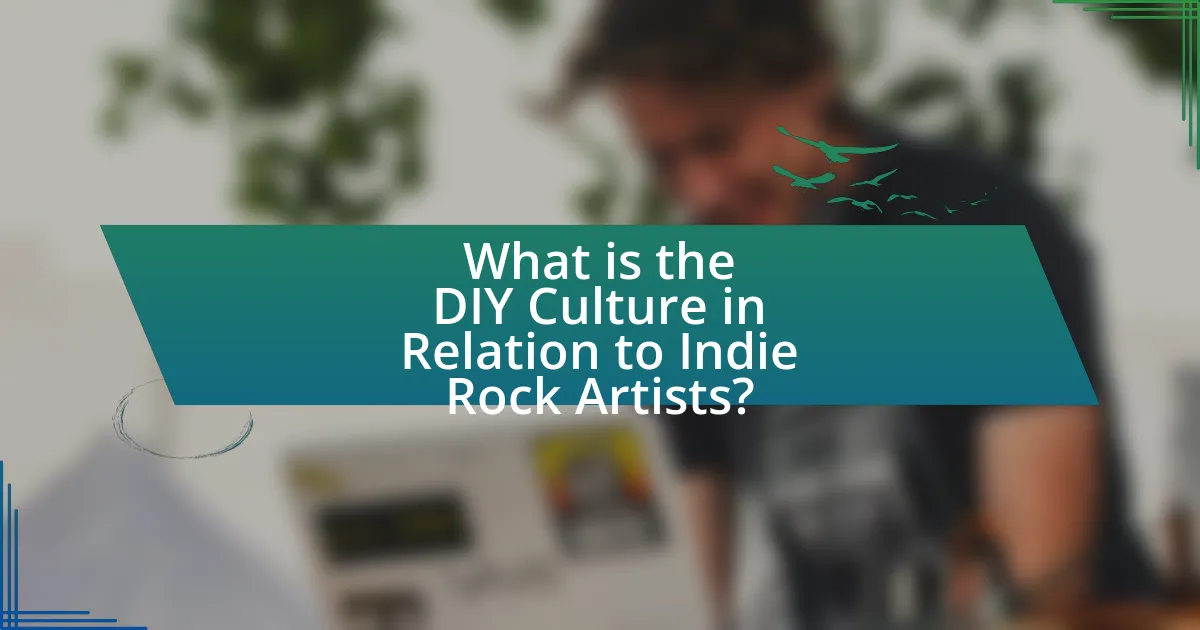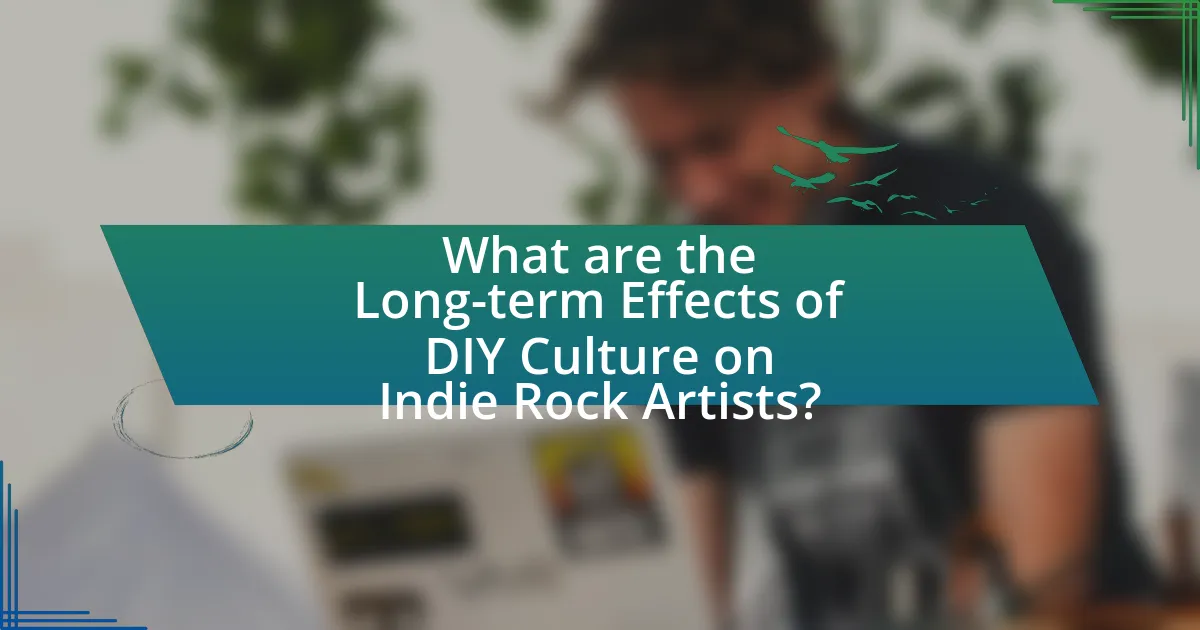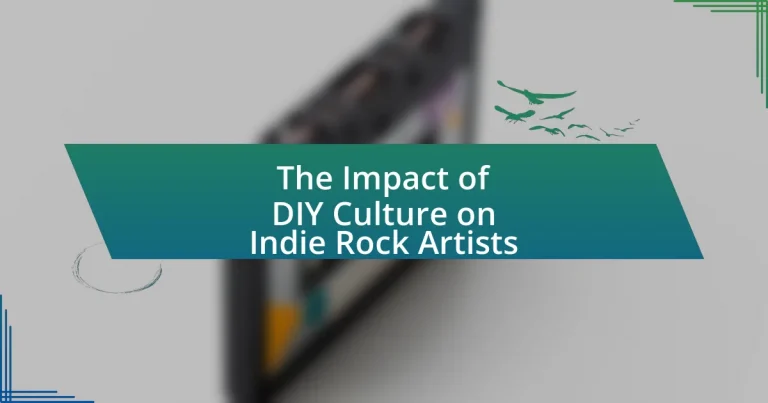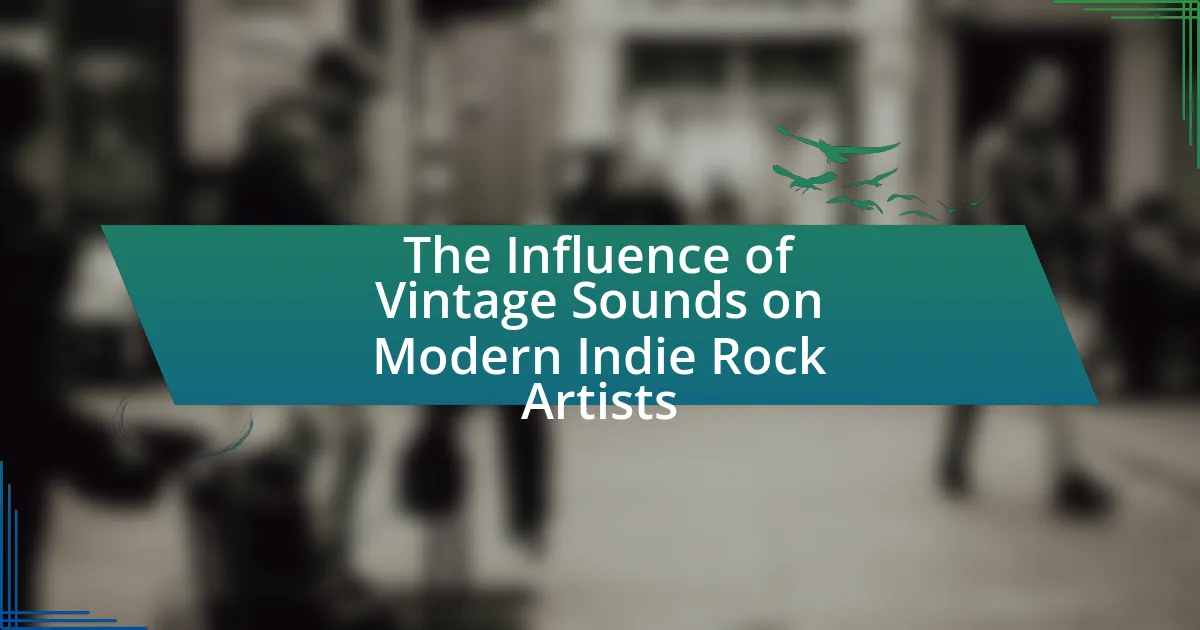The article examines the impact of DIY culture on indie rock artists, highlighting how this movement empowers musicians to take control of their creative processes, production, and distribution without reliance on major record labels. It traces the emergence of DIY culture from the punk rock movement of the late 1970s and 1980s, emphasizing the importance of self-sufficiency, creativity, and community engagement. The article discusses the influence of technology on DIY practices, the core principles that define this culture, and the challenges indie rock artists face in a DIY environment. Additionally, it explores the long-term effects of DIY culture on artistic development, community building, and the evolving landscape of the music industry.

What is the DIY Culture in Relation to Indie Rock Artists?
DIY culture in relation to indie rock artists refers to a movement where musicians take control of their creative processes, production, and distribution without relying on major record labels. This culture emphasizes self-sufficiency, allowing artists to produce music, create their own marketing strategies, and engage directly with their audience. For instance, many indie rock bands, such as Death Cab for Cutie and The Decemberists, began by self-releasing their music and organizing their own tours, which helped them build a dedicated fan base. The rise of digital platforms and social media has further facilitated this DIY approach, enabling artists to reach wider audiences without traditional industry gatekeepers.
How did DIY Culture emerge within the Indie Rock scene?
DIY culture emerged within the Indie Rock scene as a response to the commercialization of music, allowing artists to maintain creative control and independence. This movement gained momentum in the late 1970s and 1980s, influenced by punk rock’s ethos of self-production and grassroots distribution. Bands began to produce their own recordings, organize their own shows, and create independent labels, which fostered a community-oriented approach to music. The rise of affordable recording technology and the internet further facilitated this culture, enabling artists to reach audiences without relying on major record labels. Notable examples include the formation of labels like Sub Pop and the success of bands such as Sonic Youth, which exemplified the DIY spirit by prioritizing artistic integrity over commercial success.
What historical events contributed to the rise of DIY Culture?
The rise of DIY culture was significantly influenced by the punk rock movement of the 1970s, which emphasized self-production and independence from mainstream music industry practices. This movement encouraged artists to create, record, and distribute their music without relying on major record labels, exemplified by bands like The Ramones and The Sex Pistols, who often produced their own albums and organized their own tours. Additionally, the economic downturns in the late 20th century, particularly the 1980s recession, led to a greater emphasis on self-sufficiency and resourcefulness, further fueling the DIY ethos. The advent of affordable recording technology and the internet in the 1990s also played a crucial role, enabling artists to share their work widely without significant financial investment. These historical events collectively fostered an environment where individuals felt empowered to take creative control, leading to the proliferation of DIY culture in various artistic fields, including indie rock.
How has technology influenced the development of DIY Culture?
Technology has significantly influenced the development of DIY culture by providing accessible tools and platforms for creation and distribution. The advent of affordable recording equipment, software, and online platforms has empowered individuals to produce music independently, bypassing traditional industry gatekeepers. For instance, the rise of digital audio workstations (DAWs) like GarageBand and Ableton Live has enabled aspiring musicians to record high-quality tracks at home. Additionally, platforms such as Bandcamp and SoundCloud allow artists to share their work directly with audiences, fostering a community-driven approach to music distribution. This shift has led to a surge in indie rock artists who embrace DIY ethics, as evidenced by the increase in self-released albums, which accounted for over 30% of music sales in recent years.
What are the core principles of DIY Culture?
The core principles of DIY culture include self-sufficiency, creativity, and community engagement. Self-sufficiency emphasizes individuals taking initiative to create and produce their own work without relying on traditional commercial systems. Creativity encourages innovative expression and experimentation, often leading to unique artistic outputs. Community engagement fosters collaboration and support among individuals, promoting shared resources and collective growth. These principles have historically empowered indie rock artists to produce music independently, as seen in the rise of independent labels and grassroots movements in the 1980s and 1990s, which allowed artists to maintain creative control and connect directly with their audiences.
How do these principles manifest in the work of Indie Rock artists?
Indie Rock artists manifest the principles of DIY culture through their emphasis on artistic autonomy, self-production, and grassroots promotion. These artists often write, record, and distribute their music independently, allowing for creative freedom and authenticity. For instance, bands like Death Cab for Cutie and The Decemberists began by self-releasing albums before gaining mainstream recognition, showcasing how DIY practices can lead to success without major label support. Additionally, many Indie Rock artists utilize social media and platforms like Bandcamp to connect directly with fans, further exemplifying the DIY ethos of building community and fostering direct relationships. This approach not only enhances their artistic expression but also aligns with the broader cultural movement that values independence and self-sufficiency in the music industry.
Why is self-sufficiency important in the DIY ethos?
Self-sufficiency is important in the DIY ethos because it empowers individuals to create and produce without reliance on external systems or commercial entities. This autonomy fosters creativity and innovation, allowing artists to maintain control over their work and express their unique vision. For instance, many indie rock artists utilize self-sufficient practices, such as home recording and independent distribution, to cultivate a distinct sound and connect directly with their audience. This approach not only reduces costs but also enhances artistic integrity, as artists can make decisions that align with their values rather than commercial pressures.
What impact does DIY Culture have on the music industry?
DIY culture significantly democratizes the music industry by enabling artists to produce, distribute, and promote their music independently. This shift reduces reliance on traditional record labels, allowing musicians greater creative control and a direct connection with their audience. For instance, platforms like Bandcamp and SoundCloud have empowered countless indie artists to reach global audiences without the need for major label backing. According to a 2020 report by the International Federation of the Phonographic Industry, independent music accounted for 40% of global recorded music revenues, illustrating the substantial economic impact of DIY practices.
How does DIY Culture challenge traditional music industry norms?
DIY culture challenges traditional music industry norms by empowering artists to produce, distribute, and promote their music independently, bypassing major record labels. This shift allows musicians to retain creative control and a larger share of their profits, as evidenced by the rise of platforms like Bandcamp and SoundCloud, which facilitate direct artist-to-fan sales. Additionally, the DIY ethos fosters community engagement and grassroots support, as seen in the proliferation of independent venues and local music scenes that prioritize local talent over mainstream acts. This democratization of music production and distribution disrupts the traditional gatekeeping roles of record labels and radio stations, enabling a more diverse range of voices and styles to emerge in the music landscape.
What role does community play in the success of DIY Indie Rock artists?
Community plays a crucial role in the success of DIY Indie Rock artists by providing support, resources, and a platform for collaboration. This support system enables artists to share their music, gain exposure, and build a loyal fan base. For instance, local music scenes often foster connections among musicians, venues, and audiences, which can lead to opportunities for live performances and networking. Research indicates that artists who engage with their community are more likely to succeed; a study by the University of Southern California found that community engagement significantly enhances an artist’s visibility and marketability. Thus, the active participation in and support from a community directly contributes to the growth and sustainability of DIY Indie Rock artists.

How do Indie Rock Artists Utilize DIY Culture?
Indie rock artists utilize DIY culture by independently producing, recording, and distributing their music, which allows them to maintain creative control and connect directly with their audience. This approach is evident in the rise of home recording technology and platforms like Bandcamp and SoundCloud, which enable artists to share their work without the need for major label support. For instance, artists such as Sufjan Stevens and Bon Iver have famously recorded albums in home studios, showcasing the effectiveness of DIY methods. Additionally, DIY culture fosters community engagement through local shows and grassroots promotion, exemplified by the success of independent labels like Sub Pop and Merge Records, which have launched the careers of numerous indie rock bands.
What strategies do Indie Rock artists employ to promote their music?
Indie Rock artists employ various strategies to promote their music, primarily leveraging social media, live performances, and grassroots marketing. Social media platforms like Instagram, Twitter, and TikTok allow artists to engage directly with fans, share updates, and promote new releases, which is crucial for building a loyal following. Live performances, including local gigs and virtual concerts, serve as essential venues for artists to showcase their music and connect with audiences, often leading to increased word-of-mouth promotion. Additionally, grassroots marketing techniques, such as distributing flyers, collaborating with local businesses, and utilizing email newsletters, help artists reach their target audience effectively. These strategies are supported by the DIY culture that emphasizes self-promotion and community engagement, allowing Indie Rock artists to thrive in a competitive music landscape.
How do social media platforms facilitate DIY promotion?
Social media platforms facilitate DIY promotion by providing artists with accessible tools to reach and engage their audience directly. These platforms, such as Instagram, Facebook, and Twitter, allow indie rock artists to share their music, updates, and creative content without the need for traditional marketing channels. For instance, a study by the Pew Research Center in 2021 found that 72% of adults in the U.S. use social media, which highlights the vast potential audience available for artists to connect with. Additionally, features like hashtags, stories, and live streaming enable artists to create interactive experiences, fostering community engagement and increasing visibility. This direct interaction not only helps in building a loyal fan base but also allows artists to receive immediate feedback, which can be crucial for their growth and promotion efforts.
What are the benefits of grassroots marketing for Indie Rock artists?
Grassroots marketing offers significant benefits for Indie Rock artists by fostering direct connections with their audience. This approach allows artists to build a loyal fan base through personal interactions, which can lead to increased attendance at live shows and higher merchandise sales. According to a study by the Music Industry Research Association, artists who engage in grassroots marketing strategies often see a 30% increase in local show attendance compared to those who rely solely on traditional marketing methods. Additionally, grassroots marketing is cost-effective, enabling Indie Rock artists to promote their music without the financial burden of large advertising campaigns. This method also encourages community engagement, as artists often collaborate with local venues and businesses, enhancing their visibility and support within the community.
How do Indie Rock artists create and distribute their music independently?
Indie Rock artists create and distribute their music independently by utilizing home recording technology and digital platforms. Many artists leverage affordable recording equipment and software, allowing them to produce high-quality music without the need for a traditional studio. This approach is supported by the rise of digital distribution services like Bandcamp, DistroKid, and TuneCore, which enable artists to release their music directly to consumers without intermediaries. According to a 2021 report by the International Federation of the Phonographic Industry, independent artists accounted for 40% of global music revenues, highlighting the effectiveness of these independent methods.
What tools and resources are available for DIY music production?
DIY music production is facilitated by a variety of tools and resources, including digital audio workstations (DAWs), audio interfaces, microphones, and online tutorials. Popular DAWs such as Ableton Live, FL Studio, and GarageBand provide musicians with the software needed to compose, record, and edit music. Audio interfaces, like Focusrite Scarlett and PreSonus AudioBox, enhance sound quality by connecting instruments and microphones to computers. Additionally, high-quality microphones, such as the Shure SM58 and Audio-Technica AT2020, are essential for capturing vocals and instruments. Online platforms like YouTube and Skillshare offer tutorials and courses that help aspiring producers learn techniques and improve their skills. These resources empower indie rock artists to create professional-sounding music independently, reflecting the essence of DIY culture in the music industry.
How do Indie Rock artists navigate distribution without major labels?
Indie Rock artists navigate distribution without major labels by utilizing digital platforms and independent distribution services. These artists often leverage services like Bandcamp, DistroKid, and TuneCore, which allow them to distribute their music directly to streaming platforms and online stores while retaining a larger share of their profits. According to a 2021 report by the International Federation of the Phonographic Industry, independent labels and artists accounted for 40% of global recorded music revenues, highlighting the effectiveness of these distribution methods. Additionally, social media and direct fan engagement through platforms like Instagram and TikTok enable artists to promote their music and build a loyal audience without the need for traditional label support.
What challenges do Indie Rock artists face in a DIY environment?
Indie Rock artists face significant challenges in a DIY environment, primarily due to limited resources and exposure. These artists often lack access to professional recording studios, marketing budgets, and distribution channels, which can hinder their ability to produce high-quality music and reach wider audiences. According to a 2020 study by the University of Southern California, 70% of independent musicians reported difficulties in gaining visibility in a saturated market, highlighting the competitive nature of the industry. Additionally, the burden of managing multiple roles—such as songwriting, performing, and promotion—can lead to burnout, with 60% of surveyed artists indicating that the stress of self-management negatively impacts their creativity and productivity.
How do financial constraints affect the DIY approach?
Financial constraints significantly limit the DIY approach by restricting resources available for production, promotion, and distribution. Indie rock artists often rely on personal funds or small budgets, which can lead to compromises in quality and reach. For instance, a study by the University of Southern California found that 70% of independent musicians reported financial limitations as a barrier to producing high-quality recordings. This financial pressure can force artists to prioritize cost-effective methods, such as home recording and social media marketing, over traditional, more expensive avenues. Consequently, while financial constraints can foster creativity and innovation, they also pose challenges that can hinder an artist’s ability to fully realize their vision and connect with a broader audience.
What are the common pitfalls of self-promotion for Indie Rock artists?
Common pitfalls of self-promotion for Indie Rock artists include over-saturation of social media, lack of targeted marketing, and neglecting audience engagement. Over-saturation occurs when artists excessively post content, leading to audience fatigue and diminished interest. A lack of targeted marketing results in reaching the wrong audience, which can waste resources and time. Neglecting audience engagement means failing to interact with fans, which can hinder relationship-building and loyalty. According to a study by the Berklee College of Music, effective engagement strategies can increase fan retention by up to 30%, highlighting the importance of maintaining a connection with the audience.

What are the Long-term Effects of DIY Culture on Indie Rock Artists?
The long-term effects of DIY culture on indie rock artists include increased creative autonomy, sustainable career models, and a stronger community connection. DIY culture empowers artists to produce, distribute, and promote their music independently, leading to a greater sense of ownership over their work. This autonomy often results in diverse musical experimentation, as artists are not constrained by commercial pressures.
Moreover, the rise of digital platforms has enabled indie rock artists to establish sustainable career models without relying on traditional record labels. For instance, artists can leverage crowdfunding and social media to finance their projects and engage directly with fans, fostering loyalty and support.
Additionally, DIY culture cultivates a sense of community among indie rock artists, encouraging collaboration and mutual support. This interconnectedness can lead to collective growth and innovation within the genre. Research by the University of Southern California highlights that indie artists who embrace DIY practices often experience longer-lasting careers due to their ability to adapt and connect with audiences on a personal level.
How does DIY Culture influence the artistic development of Indie Rock artists?
DIY culture significantly influences the artistic development of Indie Rock artists by promoting creative autonomy and encouraging experimentation. This cultural movement allows artists to produce, distribute, and promote their music independently, fostering a sense of ownership over their work. For instance, many Indie Rock musicians utilize home recording techniques and social media platforms to reach audiences without the constraints of traditional record labels. This approach not only enhances their artistic expression but also leads to a diverse range of sounds and styles within the genre. The success of bands like Death Cab for Cutie and The Decemberists, who initially gained popularity through DIY methods, exemplifies how this culture can propel artists into mainstream recognition while maintaining their unique artistic identities.
What skills do artists gain through a DIY approach?
Artists gain a variety of skills through a DIY approach, including self-management, creative problem-solving, and technical proficiency. Self-management skills are developed as artists take on multiple roles, such as marketing, finance, and project management, which enhances their ability to organize and execute their artistic vision. Creative problem-solving skills are honed as artists navigate challenges independently, often leading to innovative solutions that reflect their unique style. Technical proficiency is also gained as artists learn to use various tools and technologies for production, promotion, and distribution, which is essential in the modern music landscape. These skills collectively empower artists to maintain greater control over their work and career trajectory.
How does the DIY experience shape an artist’s identity and brand?
The DIY experience significantly shapes an artist’s identity and brand by fostering independence and authenticity. Artists engaged in DIY culture often take control of their creative processes, from production to distribution, which allows them to express their unique vision without external constraints. This autonomy cultivates a strong personal brand that resonates with audiences seeking genuine connections. For instance, many successful indie rock artists, such as Sonic Youth and The White Stripes, began their careers in DIY settings, which helped them establish a distinct identity that set them apart in a crowded music landscape. The emphasis on self-reliance and grassroots promotion in DIY culture not only enhances an artist’s credibility but also builds a loyal fan base that appreciates their authenticity and commitment to their craft.
What is the future of DIY Culture in the Indie Rock scene?
The future of DIY culture in the Indie Rock scene is poised for growth and evolution, driven by technological advancements and a shift in consumer behavior. As artists increasingly leverage digital platforms for music distribution and promotion, the accessibility of tools for recording and marketing has democratized the music-making process. For instance, the rise of home recording software and social media allows independent musicians to reach global audiences without the need for traditional record labels. This trend is supported by data showing that independent artists generated over $1 billion in revenue in 2020, highlighting the financial viability of DIY approaches. Consequently, the Indie Rock scene is likely to see a continued emphasis on authenticity and grassroots movements, as artists prioritize creative control and direct engagement with their fanbase.
How might emerging technologies impact DIY practices in music?
Emerging technologies significantly enhance DIY practices in music by providing accessible tools for creation, distribution, and promotion. For instance, software like GarageBand and Ableton Live allows musicians to produce high-quality recordings at home, reducing the need for expensive studio time. Additionally, platforms such as Bandcamp and SoundCloud enable artists to distribute their music directly to audiences without traditional label support, fostering greater independence. The rise of social media also facilitates direct engagement with fans, allowing artists to build their brand and community effectively. These advancements collectively empower indie rock artists to take control of their creative processes and reach wider audiences, as evidenced by the increasing number of successful independent musicians who leverage these technologies to thrive in the music industry.
What trends are shaping the evolution of DIY Culture among new Indie Rock artists?
The evolution of DIY culture among new Indie Rock artists is primarily shaped by technological advancements, increased access to distribution platforms, and a shift towards authenticity in music production. Technological advancements, such as affordable recording equipment and software, enable artists to produce high-quality music independently. Platforms like Bandcamp and SoundCloud provide direct access to audiences, allowing artists to bypass traditional record labels. Additionally, there is a growing emphasis on authenticity, with artists prioritizing personal expression and grassroots marketing over commercial success. This trend is supported by the rise of social media, which facilitates direct engagement with fans and fosters community-building among artists.
What practical tips can Indie Rock artists follow to thrive in a DIY environment?
Indie Rock artists can thrive in a DIY environment by leveraging social media for promotion, engaging directly with their audience, and maintaining a consistent release schedule. Social media platforms like Instagram and Twitter allow artists to build a fanbase without the need for traditional marketing, as evidenced by the success of artists like Chance the Rapper, who gained fame primarily through social media engagement. Direct interaction with fans fosters loyalty and community, which is crucial in a DIY setting. Additionally, releasing music consistently keeps the audience engaged and can lead to increased streaming numbers, as seen in the practices of successful indie bands that release singles regularly rather than waiting for full albums.
How can artists effectively build a community around their music?
Artists can effectively build a community around their music by engaging directly with their audience through social media platforms, live performances, and interactive content. This direct engagement fosters a sense of belonging and loyalty among fans, which is crucial for community building. For instance, artists who regularly interact with their followers on platforms like Instagram or Twitter can create a more personal connection, leading to increased fan investment in their music. Additionally, hosting local shows or participating in community events allows artists to connect with their audience in a tangible way, reinforcing their presence within the community. Research indicates that artists who actively engage with their fan base see a 30% increase in fan retention and loyalty, highlighting the effectiveness of these strategies in community building.
What are the best practices for managing a DIY music career?
The best practices for managing a DIY music career include establishing a strong online presence, networking effectively, and maintaining financial awareness. Artists should create and regularly update a professional website and utilize social media platforms to engage with fans and promote their music. Networking with other musicians, industry professionals, and fans can lead to collaboration opportunities and increased visibility. Additionally, managing finances by budgeting for recording, marketing, and touring expenses is crucial for sustainability. According to a 2020 study by the Music Industry Research Association, independent artists who actively engage in these practices are more likely to achieve long-term success in the music industry.




